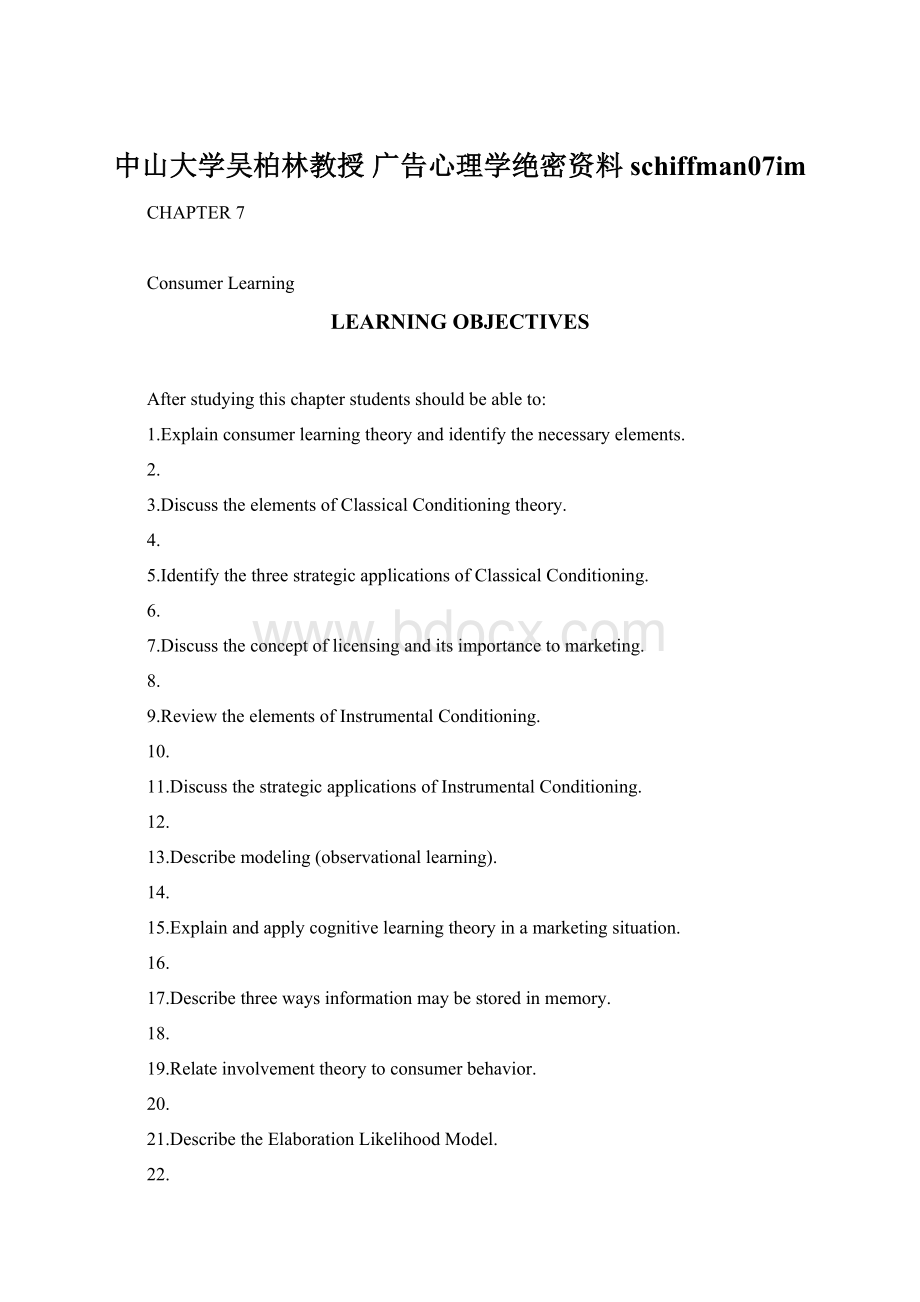中山大学吴柏林教授 广告心理学绝密资料schiffman07im.docx
《中山大学吴柏林教授 广告心理学绝密资料schiffman07im.docx》由会员分享,可在线阅读,更多相关《中山大学吴柏林教授 广告心理学绝密资料schiffman07im.docx(46页珍藏版)》请在冰豆网上搜索。

中山大学吴柏林教授广告心理学绝密资料schiffman07im
CHAPTER7
ConsumerLearning
LEARNINGOBJECTIVES
Afterstudyingthischapterstudentsshouldbeableto:
1.Explainconsumerlearningtheoryandidentifythenecessaryelements.
2.
3.DiscusstheelementsofClassicalConditioningtheory.
4.
5.IdentifythethreestrategicapplicationsofClassicalConditioning.
6.
7.Discusstheconceptoflicensinganditsimportancetomarketing.
8.
9.ReviewtheelementsofInstrumentalConditioning.
10.
11.DiscussthestrategicapplicationsofInstrumentalConditioning.
12.
13.Describemodeling(observationallearning).
14.
15.Explainandapplycognitivelearningtheoryinamarketingsituation.
16.
17.Describethreewaysinformationmaybestoredinmemory.
18.
19.Relateinvolvementtheorytoconsumerbehavior.
20.
21.DescribetheElaborationLikelihoodModel.
22.
23.Outlinemeasuresofinvolvement.
24.
25.Understandhowconsumerlearningcanbemeasured.
26.
27.Discusstheconceptsofbrandloyaltyandbrandequity.
28.
SUMMARY
Consumerlearningistheprocessbywhichindividualsacquirethepurchaseandconsumptionknowledgeandexperiencetheyapplytofuturerelatedbehavior.Somelearningisintentional;muchlearningisincidental.Basicelementsthatcontributetoanunderstandingoflearningaremotivation,cues,response,andreinforcement.
Therearetwoschoolsofthoughtastohowindividualslearn—behavioraltheoriesandcognitivetheories.Behavioraltheoristsviewlearningasobservableresponsestostimuli;whereascognitivetheoristsbelievethatlearningisafunctionofmentalprocessing.
Threetypesofbehaviorallearningtheoriesareclassicalconditioning,instrumentalconditioning,andobservational(vicarious)learning.Theprinciplesofclassicalconditioningthatprovidetheoreticalunderpinningsformanymarketingapplicationsincluderepetition,stimulusgeneralization,andstimulusdiscrimination.Neo-Pavloviantheoriesviewtraditionalclassicalconditioningascognitiveassociativelearningratherthanasreflexiveaction.
Instrumentallearningtheoristsbelievethatlearningoccursthroughatrial-and-errorprocessinwhichpositiveoutcomes(i.e.,rewards)resultinrepeatbehavior.Bothpositiveandnegativereinforcementcanbeusedtoencouragethedesiredbehavior.Reinforcementschedulescanbetotal(consistent)orpartial(fixedratioorrandom).Thetimingofrepetitionsinfluenceshowlongthelearnedmaterialisretained.Massedrepetitionsproducemoreinitiallearningthandistributedrepetitions;however,learningusuallypersistslongerwithdistributed(i.e.,spreadout)reinforcementschedules.
Cognitivelearningtheoryholdsthatthekindoflearningmostcharacteristicofhumansisproblemsolving.Cognitivetheoristsareconcernedwithhowinformationisprocessedbythehumanmind:
howisitstored,retained,andretrieved.Asimplemodelofthestructureandoperationofmemorysuggeststheexistenceofthreeseparatestorageunits:
thesensorystore,short-termstore(orworkingmemory),andlong-termstore.Theprocessesofmemoryincluderehearsal,encoding,storage,andretrieval.
Involvementtheoryproposesthatpeopleengageinlimitedinformationprocessinginsituationsoflowimportanceorrelevancetothemandinextensiveinformationprocessinginsituationsofhighrelevance.Hemispherallateralizationtheorygaverisetothetheorythattelevisionisalow-involvementmediumthatresultsinpassivelearningandthatprintandinteractivemediaencouragemorecognitiveinformationprocessing.
Measuresofconsumerlearningincluderecallandrecognitiontests,cognitiveresponsestoadvertising,andattitudinalandbehavioralmeasuresofbrandloyaltyintermsoftheconsumer’sbehaviorortheconsumer’sattitudetowardthebrand.Brandequityreferstotheinherentvalueabrandnamehasinthemarketplace.
Formarketers,themajorreasonsforunderstandinghowconsumerslearnaretoteachthemthattheirbrandisbestandtodevelopbrandloyalty.
CHAPTEROUTLINE
INTRODUCTION
1.Marketersareconcernedwithhowindividualslearnbecausetheywanttoteachthem,intheirrolesasconsumers,aboutproducts,productattributes,andpotentialconsumerbenefits;aboutwheretobuytheirproducts,howtousethem,howtomaintainthem,evenhowtodisposeofthem.
2.
3.Marketingstrategiesarebasedoncommunicatingwiththeconsumer.
4.
a)Marketerswanttheircommunicationstobenoted,believed,remembered,andrecalled.
b)
c)Forthesereasons,theyareinterestedineveryaspectofthelearningprocess.
d)
5.Thereisnosingle,universaltheoryofhowpeoplelearn.
6.
7.Therearetwomajorschoolsofthoughtconcerningthelearningprocess:
oneconsistsofbehaviorallearningtheories,theotherofcognitivelearningtheories.
8.
9.Cognitivetheoristsviewlearningasafunctionofpurelymentalprocesses,althoughbehavioraltheoristsfocusalmostexclusivelyonobservablebehaviors(responses)thatoccurastheresultofexposuretostimuli.
10.
*****UseKeyTermsbehaviorallearningtheoryandcognitivelearningtheoryHere*****
CONSUMERLEARNING
1.Consumerlearningcanbethoughtofastheprocessbywhichindividualsacquirethepurchaseandconsumptionknowledgeandexperiencethattheyapplytofuturerelatedbehavior.
2.
3.Severalpointsinthisdefinitionareworthnoting.
4.
a)First,consumerlearningisaprocess;thatis,itcontinuallyevolvesandchangesasaresultofnewlyacquiredknowledgeorfromactualexperience.
b)
c)Bothnewlyacquiredknowledgeandpersonalexperienceserveasfeedbacktotheindividualandprovidethebasisforfuturebehaviorinsimilarsituations.
d)
5.Theroleofexperienceinlearningdoesnotmeanthatalllearningisdeliberatelysought.Agreatdealoflearningisalsoincidental,acquiredbyaccidentorwithoutmucheffort.
6.
7.Thetermlearningencompassesthetotalrangeoflearning,fromsimple,almostreflexiveresponsestothelearningofabstractconceptsandcomplexproblemsolving.
8.
a)Mostlearningtheoristsrecognizetheexistenceofdifferenttypesoflearningandexplainthedifferencesthroughtheuseofdistinctivemodelsoflearning.
b)
9.Despitetheirdifferentviewpoints,learningtheoristsingeneralagreethatinorderforlearningtooccur,certainbasicelementsmustbepresent—motivation,cues,response,andreinforcement.
10.
*****UseKeyTermlearningHere;UseLearningObjective#1Here*****
Motivation
1.Motivationisbasedonneedsandgoals.
2.
a)Thedegreeofrelevance,orinvolvement,withthegoal,iscriticaltohowmotivatedtheconsumeristosearchforinformationaboutaproduct.
b)
3.Uncoveringconsumermotivesisoneoftheprimetasksofmarketers,whotrytoteachconsumersegmentswhytheirproductwillbestfulfilltheirneeds.
4.
*****UseKeyTermmotivationHere;UseLearningObjective#1Here*****
Cues
1.Ifmotivesservetostimulatelearning,cuesarethestimulithatgivedirectiontothemotives.
2.
a)Inthemarketplace,price,styling,packaging,advertising,andstoredisplaysallserveascuestohelpconsumersfulfilltheirneeds.
b)
3.Cuesservetodirectconsumerdriveswhentheyareconsistentwiththeirexpectations.
4.
*****UseKeyTermcuesHere;UseLearningObjective#1Here*****
Response
1.Howindividualsreacttoacue—howtheybehave—constitutestheirresponse.
2.
3.Aresponseisnottiedtoaneedinaone-to-onefashion.
4.
5.Aneedormotivemayevokeawholevarietyofresponses.
6.
7.Theresponseaconsumermakesdependsheavilyonpreviouslearning;that,inturn,dependsonhowrelatedresponseswerereinforcedpreviously.
8.
*****UseKeyTermresponseHere;UseLearningObjective#1Here*****
Reinforcement
1.Reinforcementincreasesthelikelihoodthataspecificresponsewilloccurinthefutureastheresultofparticularcuesorstimuli.
2.
*****UseKeyTermreinforcementHere;UseLearningObjective#1Here;UseExercise#1
Here;UseFigure7-1Here*****
BEHAVIORALLEARNINGTHEORIES
1.Behaviorallearningtheoriesaresometimescalledstimulus-responsetheories.
2.
a)Whenapersonrespondsinapredictablewaytoaknownstimulus,heorsheissaidtohave“learned.”
b)
3.Behavioraltheoriesaremostconcernedwiththeinputsandoutcomesoflearning,nottheprocess.
4.
5.Twotheoriesrelevanttomarketingareclassicalconditioningandinstrumental(oroperant)conditioning.
6.
*****UseKeyTermsstimulus-responsetheories,classicalconditioning,andinstrumental
(oroperant)conditioningHere*****
ClassicalConditioning
1.Earlyclassicalconditioningtheoristsregardedallorganismsaspassiverecipients.
2.
a)Conditioninginvolvedbuildingautomaticresponsestostimuli.
b)
3.IvanPavlovwasthefirsttodescribeconditioningandtoproposeitasageneralmodelofhowlearningoccurs.
4.
a)ForPavlov,conditionedlearningresultswhenastimulusthatispairedwithanotherstimuluselicitsaknownresponseandservestoproducethesameresponsewhenusedalone.
b)
c)Heuseddogstodemonstratehistheories.
d)
e)Thedogswerehungryandhighlymotivatedtoeat.
f)
g)Pavlovsoundedabellandthenimmediatelyappliedameatpastetothedogs’tongues,whichcausedthemtosalivate.
h)
i)Afterasufficientnumberofrepetitionsofthebellsound,followedalmostimmediatelybythefood,thebellalonecausedthedogstosalivate.
j)
5.Inaconsumerbehaviorcontext,anunconditionedstimulusmightconsistofawell-knownbrandsymbol(e.g.,theMicrosoft“windows”icon)thatimpliestechnologicalsuperiorityandtrouble-freeoperation(theunconditionedresponse).
6.
7.Conditionedstimul